Janice Hardy's Blog
November 22, 2025
The Overwritten Novel: How to Identify & Fix Purple Prose in Your Novel
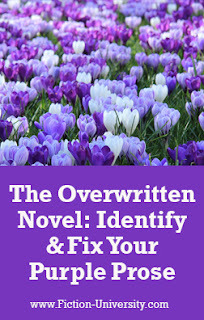 By Janice Hardy
By Janice HardyBe wary of going too far and turning a good sentence (or scene) into an overwritten mess.
The term "purple prose" has been around as long as I've been writing, and chances are you've heard it too.
If you're unfamiliar with the term, purple or flowery prose is so filled with adjectives and adverbs, similes and metaphors, that it screams "Hey look! I'm fancy writing" and distracts readers from the actual story. You often need a thesaurus just to read it.
Overwritten text is trying too hard to sound "written" or trying to explain too much. For example, a sentence that uses fifteen words when three is enough, and half of them are adjectives. Or a sentence that explains every single step in a task that doesn't need it.
If you ever thought to yourself, "Yeah, I get it, he was angry, move on" then you probably read an overwritten passage.
Overwriting bloats a novel and usually kills the pacing and narrative drive, because the focus is on the description, not the action. Even when what you're describing is action.Written by Janice Hardy. Fiction-University.com
November 15, 2025
Message for M. Reader: Are You Telegraphing Your Plot?
 By Janice Hardy
By Janice HardyHints are great, but be wary of making it too obvious what's going to happen in your novel.
If you've ever watched a TV show or movie and heard a random stranger say something like, "Well now, we haven't use that road since a big old sinkhole opened up ten years ago," you've stumbled upon a telegraphed clue. You know that sinkhole is totally where the hero is going to lead the horrible monster or bad guy chasing him at the climax—and he does.
Kinda takes all the fun out of it, right?
While foreshadowing is a wonderful tool that can heighten tension and make the reader eager to know what will happen, telegraphing steals all the tension and takes the mystery out of those hints. Continue ReadingWritten by Janice Hardy. Fiction-University.com
November 8, 2025
Shhh! 3 Things Silent Movies Can Teach us About Storytelling
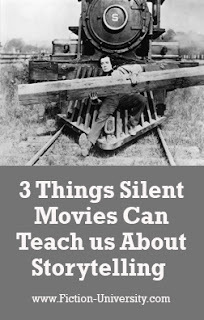 By Janice Hardy
By Janice HardyYou can learn a lot from the classics.
My husband and I are big silent movie fans (well, fans of movies in general, really). But it's especially interesting to watch movies that are 90 to 100 years old, and even more interesting to see how storytelling hasn't changed all that much in all those years. What worked back in 1920 still works today.
What's even more fun, is that the first time many of the classic sight gags were done were in silent movies. These folks created them.
Filmed in 1926, the Buster Keaton film, The General , is an excellent example of tight plotting and storyboarding. Nothing is wasted in this film. If you see a detail on screen, you can be sure it'll come into play at some point. And the best part? It still surprises you. I can't tell you how often we laughed over something we should have seen coming.
That’s the secret of great storytelling. Continue ReadingWritten by Janice Hardy. Fiction-University.com
November 1, 2025
The Question You Should Ask for Every Scene
 By Janice Hardy
By Janice HardyIf you can’t explain why a scene exists, you probably shouldn’t write it
Writers ask a lot of questions while drafting a novel—who are the characters, how does the worldbuilding work, what are the goals, motivations, and plot twists? And readers have their own questions driving them forward. Will the hero win? Will the lovebirds fall in love? Will the hockey team survive?
But we don’t always ask the question that can save us a ton of time and frustration.
What’s the point of this scene?
This question isn’t about the story's theme or the protagonist's goals—it’s about why you decided to put this scene into your story in the first place.
If you can’t answer why a scene is in your novel, it's a huge red flag that the scene might not be serving the story.
Continue ReadingWritten by Janice Hardy. Fiction-University.com
September 27, 2025
5 Ways Repetition Hurts Your Novel
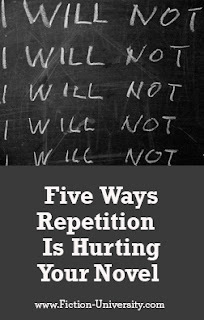 By Janice Hardy
By Janice HardyHow to spot and fix those sneaky repetitions that weaken your prose.
Aside from a great one liner, a declaration of love, or a juicy piece of gossip, most people don’t like to hear the same thing over and over. This is doubly true for readers, and repeating yourself in a novel can make your story feel redundant, stale, or even poorly edited.
When you consider a typical novel runs between 80,000 and 100,000 words, it’s no wonder words (and even ideas) get repeated. Some of those words readers don’t notice (such as said) and others stand out even if you only used them once or twice (like antidisestablishmentarianism).
Repetition drags down your pacing and makes even strong prose feel clunky.Continue ReadingWritten by Janice Hardy. Fiction-University.com
September 13, 2025
Is That You? Developing Voices for Different Point of View Characters
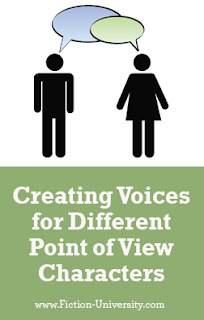 By Janice Hardy
By Janice HardyUnique, stand-out characters have unique, stand-out voices, so it's important to consider how every character in your book sounds.
I'm the kind of writer who doesn't do a lot of character work before I start a novel, but one of the first things I figure out is voice. For me, what a character sounds like is how I learn who they are and what their backstory is. I usually know a few details going in, but the bulk of my characters get revealed as I write them.
The more distinct your character voices are, the easier it is for readers (and you, honestly) to keep track of who’s who. If your witty rogue, your brooding warrior, and your quiet scholar all speak and think in identical ways, readers won’t just get confused—they’ll stop believing in the characters as people. Continue ReadingWritten by Janice Hardy. Fiction-University.com
September 6, 2025
4 Signs You Might Be Confusing, Not Intriguing, in Your Opening Scene
 By Janice Hardy
By Janice HardyThe opening scene of a novel walks a fine line between piquing curiosity and confusing the reader.
Opening scenes are under a lot of pressure. They need to pique reader interest, set the scene, introduce characters, and give just enough information to intrigue, but not overload or confuse the reader.
That’s a lot to ask of 250 words.
While trying to hook readers and not give everything away, it’s common for an opening scene to be less than forthcoming with information. We hold back details to sound mysterious, we hide clues we think will reveal too much, and sometimes, we even bend over backward not to provide the exact details readers need to get sucked into the story.
The fastest way to lose a reader isn’t boredom—it’s confusion.
Continue ReadingWritten by Janice Hardy. Fiction-University.com
August 30, 2025
Whoa, That’s Tense. 3 Ways to Raise the Tension in Your Scenes
 By Janice Hardy
By Janice HardyTension isn’t about what’s happening—it’s about what might happen next.
Great stories keep us on the edge of our seats, but they aren’t always packed with nonstop explosions or fight scenes. Sometimes, it’s a drip-drip-drip of water that plays on your nerves, a heavy silence before someone drops a secret that will change everything, or a glance that lingers too long and means so much. What makes us tense is the anticipation—that nagging sense that something bad could happen any second.
The movie Sanctum is a fantastic example of how to take advantage of tension. Set in a labyrinth of underwater caves where one wrong move means death, it layers danger, dread, and impossible choices until viewers are holding their breath right alongside the characters. Even though I’ve never been cave diving, I have dived wrecks with tight, confined spaces, and I know how quickly “this is fine” can shift into “this can kill me.” One wrong turn, one bad decision, and you’re in real trouble.Continue ReadingWritten by Janice Hardy. Fiction-University.com
August 23, 2025
Where Does Your Novel's Conflict Come From?
 By Janice Hardy
By Janice HardyOne of the more common reasons why a story isn't working is the lack of a strong conflict.
Without conflict there is no story. No matter what the story is, you can boil it down to “The protagonist wants something and someone or something is standing in the way.” The novel is about getting past that person or thing to resolve the conflict and earn the protagonist their goal.
As simple as that sounds, it’s not always so clear when you’re looking at your idea. Ideas are often more concept than plot, a great premise without a solid story yet, and the conflict at the core of that idea is fuzzy. Your instinct tells you it’s there, but critique partners or even agents just aren’t seeing it.
In most cases, the conflict isn’t strong enough yet, or it’s not clear what the actual conflict (and problem) is.
Continue ReadingWritten by Janice Hardy. Fiction-University.com
August 16, 2025
A 5-Minute Fix for a Blah Scene
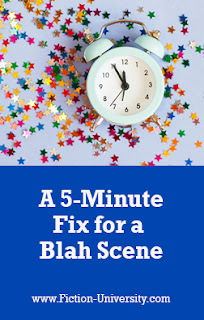 By Janice Hardy
By Janice HardySometimes the best fixisn’t changing what characters say—it’s changing where they say it.
Before I dive in, I did a guest post on Monday at Writers in the Storm, on "5 Paths to Plotting Your Novel". Now, back to our regularly scheduled post…
This might be sacrilegious as a science fiction and fantasywriter, but I dislike writing description—especially settings. I’m more of adialogue and action gal, and my first drafts (okay, sometimes second drafts aswell), have a lot of “white room” scenes, where nothing about the setting ismentioned. This was a big problem in my early writing days, since SFF readersenjoy the world building and setting and all the things I had to slog throughto write.
I got feedback such as:
I can’t picture the setting Where is this happening? Could they interact more with the room? I feel unanchored, and there’s no sense of placeAll of it was justified, and after a lot of reading,learning, and forcing myself to just doit, I found a way to enjoy writing setting descriptors.
Continue ReadingWritten by Janice Hardy. Fiction-University.com


